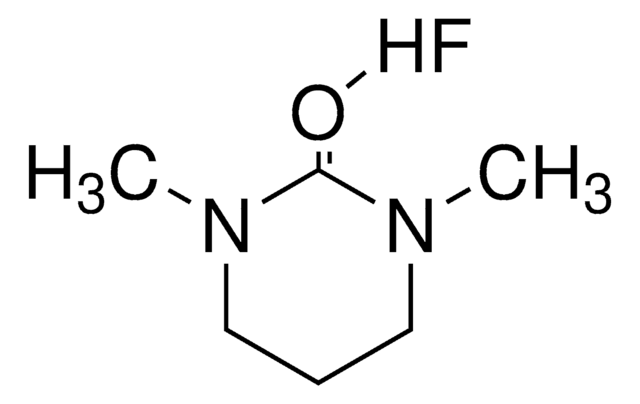8.14371
Triethylamine trishydrofluoride
for synthesis
Synonim(y):
Triethylamine trishydrofluoride
About This Item
Polecane produkty
Poziom jakości
Postać
liquid
pH
3 (20 °C in H2O, saturated aqueous solution)
tw
70 °C/19.9 hPa
temp. przejścia
flash point 88 °C
gęstość
1.00 g/cm3 at 20 °C
temp. przechowywania
2-30°C
InChI
1S/C6H15N.3FH/c1-4-7(5-2)6-3;;;/h4-6H2,1-3H3;3*1H
Klucz InChI
IKGLACJFEHSFNN-UHFFFAOYSA-N
Powiązane kategorie
Zastosowanie
- Asymmetric synthesis of fluoroamines from chiral aziridines: This study explores the use of triethylamine trishydrofluoride in the synthesis of fluoroamines, highlighting its role in enhancing reaction selectivity and efficiency (Park et al., 2014).
- Recent advance in the synthesis of (1, 1-difluoroethyl) arenes: This paper discusses recent advancements in the synthesis of difluoroethyl arenes using triethylamine trishydrofluoride, contributing to the development of new fluorination techniques (Li et al., 2018).
- Quantification of hydrogen fluoride-based reagents using a bifunctional NMR internal standard: Describes the quantification of reagents like triethylamine trishydrofluoride in chemical syntheses, emphasizing the accuracy of measurement techniques (Hammond et al., 2016).
- Extensive CRISPR RNA modification reveals chemical compatibility and structure-activity relationships for Cas9 biochemical activity: This research utilizes triethylamine trishydrofluoride for RNA modifications in CRISPR-Cas9 processes, showing its potential in genetic engineering (O′Reilly et al., 2019).
Komentarz do analizy
Colour (visual): colourless, almost colourless
Density (d 20 °C/ 4 °C): 0.995 - 1.000
Identity (IR): passes test
Hasło ostrzegawcze
Danger
Zwroty wskazujące rodzaj zagrożenia
Zwroty wskazujące środki ostrożności
Klasyfikacja zagrożeń
Acute Tox. 1 Dermal - Acute Tox. 2 Inhalation - Acute Tox. 2 Oral - Eye Dam. 1 - Skin Corr. 1A
Kod klasy składowania
6.1A - Combustible, acute toxic Cat. 1 and 2 / very toxic hazardous materials
Klasa zagrożenia wodnego (WGK)
WGK 3
Temperatura zapłonu (°F)
190.4 °F
Temperatura zapłonu (°C)
88 °C
Certyfikaty analizy (CoA)
Poszukaj Certyfikaty analizy (CoA), wpisując numer partii/serii produktów. Numery serii i partii można znaleźć na etykiecie produktu po słowach „seria” lub „partia”.
Masz już ten produkt?
Dokumenty związane z niedawno zakupionymi produktami zostały zamieszczone w Bibliotece dokumentów.
Nasz zespół naukowców ma doświadczenie we wszystkich obszarach badań, w tym w naukach przyrodniczych, materiałoznawstwie, syntezie chemicznej, chromatografii, analityce i wielu innych dziedzinach.
Skontaktuj się z zespołem ds. pomocy technicznej





![1-Chloromethyl-4-fluoro-1,4-diazoniabicyclo[2.2.2]octane bis(tetrafluoroborate) >95% in F+ active](/deepweb/assets/sigmaaldrich/product/structures/206/487/53d52ee5-ef71-4e9a-9bc8-938b68b98d5d/640/53d52ee5-ef71-4e9a-9bc8-938b68b98d5d.png)



